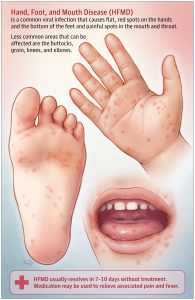
Hand, Foot, and Mouth Disease – Info You Should Know
By Dr. Joseph Mechak
As we head into summer, a new panel of virus take center stage in our community. One of the most common summer viruses is the Coxsackievirus which causes Hand, Foot, and Mouth Disease (HFMD). Coxsackievirus is highly contagious and shared easily among family members and daycare or preschool classrooms. I hear a lot of misplaced fear and anxiety about HFMD so lets talk facts so you know what to expect if (read: when) your child gets HFMD.
The Basics:
- Hand, Foot and Mouth Disease is a common and very contagious viral infection in children caused by the coxsackievirus. It is most common during summer and early fall.
- It is most common in infants and children under 5 but may occur at any age. Most children will have HFMD at some point during childhood
- Symptoms include fever, runny nose, sore throat or mouth pain, fussiness and decreased appetite, and a characteristic rash. The rash is made of small red bumps/blisters on the palms of the hands, soles of the feet, in and around the mouth, and in the diaper area – though it may be anywhere on the body. Sores, especially in the mouth, can be painful.
- On average, it takes 3-6 days from exposure for symptoms to develop. Symptoms are most severe in the first 2-3 days and typically resolve within 7-10 days.
- Skin on the fingers and toes may peel 1-2 weeks after resolution of symptoms. Cracked nails are also common 1-2 months after the infection.
- The virus is very contagious and can spread quickly in daycare centers and schools. This infection spreads through direct contact with saliva, mucus, drainage from a skin lesion, or feces. This can occur when a child’s hands are dirty and they put their hands in their mouth or touch a toy that another child plays with.
 Photo: Cox and Levent, JAMA. 2018;320(23):2492
Photo: Cox and Levent, JAMA. 2018;320(23):2492
Treatment Basics:
- Treatment for Hand, Foot and Mouth Disease is supportive. There is no role for antibiotics, steroids, or other prescription medications. Support your child’s symptoms with:
- Fever and pain control: Use Acetaminophen and Ibuprofen for fever control or pain/discomfort. Acetaminophen can be used every 4 – 6 hours (up to 4 times/day). Ibuprofen may also be used every 6 hours if your child is older than 6 months. These may be alternated or given together.
- Hydration: Encourage small/frequent sips of formula/breast milk, Pedialyte and/or water (if older than 6 months). The best measure of hydration is urine output. Generally we like at least 4 voids in 24 hours.
- Magic Mouthwash: A 1:1 mixture of liquid Maalox and liquid Benadryl can coat and soothe sores in the mouth. Your child can swish and spit this mixture or you may ‘paint it’ on visible ulcers in the mouth with a cotton ball or swab.
- Prevent spread: Wash hands frequently, especially after changing diapers and blowing noses. Clean, rinse and sanitize contaminated toys
When to seek care:
- Hand, Foot and Mouth can generally be managed from home with the advice above, but seek care:
- If fever lasts longer than 4-5 days
- If there is concern for dehydration with decreased number of wet diapers
- If your child is inconsolable crying or fussy
- If your child is lethargic
- If you are concerned
When to return to school/activities:
- Your child may return to school when fever free for >24 hours without medication and once their rash is improving, drying out and no new sores have developed for more than 24 hours.
Additional Resources:
*Cover photo credit: CDC.gov











Leave a reply